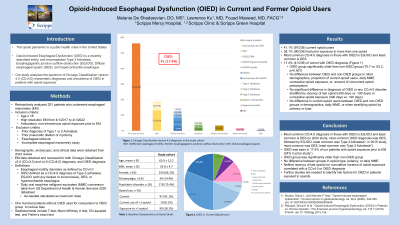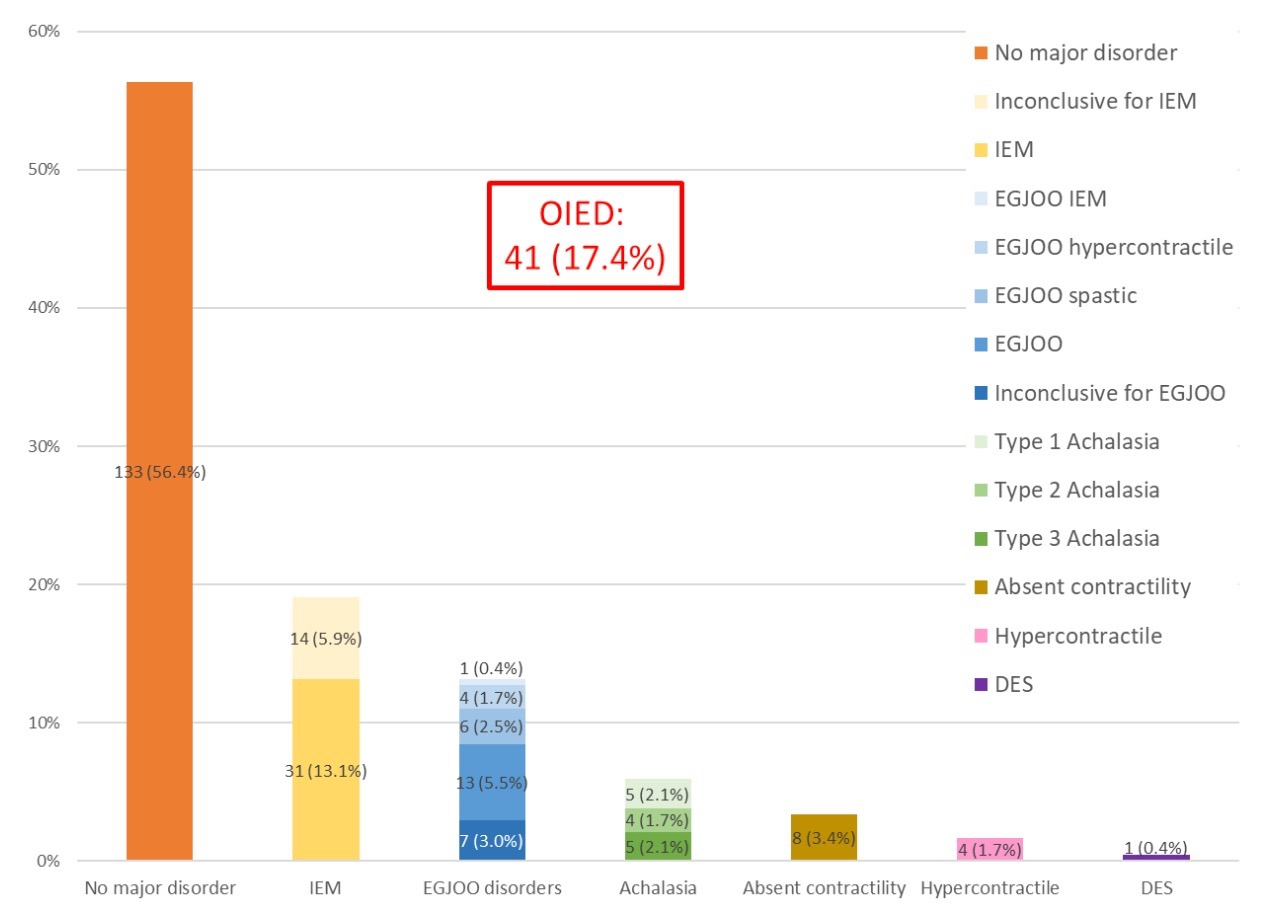Tuesday Poster Session
Category: Esophagus
P3271 - Opioid-Induced Esophageal Dysfunction in Current and Former Opioid Users
Tuesday, October 24, 2023
10:30 AM - 4:00 PM PT
Location: Exhibit Hall

Has Audio

Melanie H. De Shadarevian, DO, MS
Scripps Mercy Hospital
San Diego, CA
Presenting Author(s)
Melanie H. De Shadarevian, DO, MS1, Lawrence Ku, MD2, Fouad J. Moawad, MD3
1Scripps Mercy Hospital, San Diego, CA; 2Scripps Clinic, La Jolla, CA; 3Scripps, La Jolla, CA
Introduction: The opioid epidemic is a national issue relevant to gastroenterology. OIED is a recently described entity. Our study analyzes the spectrum of Chicago Classification version 4.0 (CCv4.0) manometric diagnoses and prevalence of OIED in patients with opioid exposure.
Methods: We retroactively analyzed patients with esophageal manometry (EM) from 4/1/2017 to 4/1/2022, age ≥18 years, and opioid exposure prior to EM. Patients with a history of type 1 or 2 achalasia, pneumatic dilation, myotomy, esophageal stricture, or incomplete EM were excluded. OIED was defined as CCv4.0 diagnosis of type 3 achalasia, esophagogastric junction outflow obstruction (EGJOO), distal esophageal spasm (DES), or hypercontractile esophagus. Daily oral morphine milligram equivalent (MME) was calculated, and as needed prescriptions set at the maximum daily dose. A random subgroup of 100 patients without OIED was used for comparison to the OIED group due to a large difference in group sizes.
Results: 236 unique patients were analyzed. Average age was 65.9 years, average BMI was 24.8, and 66.1% (156/236) were female (Table 1). 41.1% (97/236) were current opioid users, and 38.1% (90/236) had prior exposure to more than one opioid. The most common CCv4.0 diagnoses were no major disorder, ineffective esophageal motility, and EGJOO disorders (Figure 1). 17.4% (41/236) had an OIED diagnosis.
Our OIED group was significantly older than the non-OIED group (70.7 vs. 63.2, p=0.001). No difference was seen between the groups in other demographics, proportion of current opioid users, daily MME, cumulative opioid exposure, or number of concurrent opioid prescriptions. There was no significant difference in diagnosis of OIED or any CCv4.0 disorder for patients whether stratified by recency of last opioid (≤90 days vs. >90 days) or cumulative opioid exposure (≤90 days vs. >90 days). In current opioid users, there was no difference between OIED and non-OIED groups in demographics, daily MME, or when stratifying opioid by potency or type.
Discussion: No major disorder, IEM, and EGJOO disorders were the most common CCv4.0 diagnoses. OIED was seen in 17.4% of our patients with opioid exposure prior to EM. Our OIED group was significantly older than the non-OIED group, but did not differ in opioid type, potency, or daily MME. Neither recency of last opioid nor cumulative duration of opioid exposure correlated with a CCv4.0 or OIED diagnosis. Further studies are needed to identify risk factors for OIED in current and former opioid users.

Disclosures:
Melanie H. De Shadarevian, DO, MS1, Lawrence Ku, MD2, Fouad J. Moawad, MD3. P3271 - Opioid-Induced Esophageal Dysfunction in Current and Former Opioid Users, ACG 2023 Annual Scientific Meeting Abstracts. Vancouver, BC, Canada: American College of Gastroenterology.
1Scripps Mercy Hospital, San Diego, CA; 2Scripps Clinic, La Jolla, CA; 3Scripps, La Jolla, CA
Introduction: The opioid epidemic is a national issue relevant to gastroenterology. OIED is a recently described entity. Our study analyzes the spectrum of Chicago Classification version 4.0 (CCv4.0) manometric diagnoses and prevalence of OIED in patients with opioid exposure.
Methods: We retroactively analyzed patients with esophageal manometry (EM) from 4/1/2017 to 4/1/2022, age ≥18 years, and opioid exposure prior to EM. Patients with a history of type 1 or 2 achalasia, pneumatic dilation, myotomy, esophageal stricture, or incomplete EM were excluded. OIED was defined as CCv4.0 diagnosis of type 3 achalasia, esophagogastric junction outflow obstruction (EGJOO), distal esophageal spasm (DES), or hypercontractile esophagus. Daily oral morphine milligram equivalent (MME) was calculated, and as needed prescriptions set at the maximum daily dose. A random subgroup of 100 patients without OIED was used for comparison to the OIED group due to a large difference in group sizes.
Results: 236 unique patients were analyzed. Average age was 65.9 years, average BMI was 24.8, and 66.1% (156/236) were female (Table 1). 41.1% (97/236) were current opioid users, and 38.1% (90/236) had prior exposure to more than one opioid. The most common CCv4.0 diagnoses were no major disorder, ineffective esophageal motility, and EGJOO disorders (Figure 1). 17.4% (41/236) had an OIED diagnosis.
Our OIED group was significantly older than the non-OIED group (70.7 vs. 63.2, p=0.001). No difference was seen between the groups in other demographics, proportion of current opioid users, daily MME, cumulative opioid exposure, or number of concurrent opioid prescriptions. There was no significant difference in diagnosis of OIED or any CCv4.0 disorder for patients whether stratified by recency of last opioid (≤90 days vs. >90 days) or cumulative opioid exposure (≤90 days vs. >90 days). In current opioid users, there was no difference between OIED and non-OIED groups in demographics, daily MME, or when stratifying opioid by potency or type.
Discussion: No major disorder, IEM, and EGJOO disorders were the most common CCv4.0 diagnoses. OIED was seen in 17.4% of our patients with opioid exposure prior to EM. Our OIED group was significantly older than the non-OIED group, but did not differ in opioid type, potency, or daily MME. Neither recency of last opioid nor cumulative duration of opioid exposure correlated with a CCv4.0 or OIED diagnosis. Further studies are needed to identify risk factors for OIED in current and former opioid users.

Figure: Figure 1
Chicago Classification version 4.0 diagnoses in the study cohort ;
IEM: Ineffective esophageal motility. EGJOO: esophagogastric junction outflow obstruction. DES: distal esophageal spasm.
Chicago Classification version 4.0 diagnoses in the study cohort ;
IEM: Ineffective esophageal motility. EGJOO: esophagogastric junction outflow obstruction. DES: distal esophageal spasm.
Disclosures:
Melanie De Shadarevian indicated no relevant financial relationships.
Lawrence Ku indicated no relevant financial relationships.
Fouad Moawad: AstraZeneca – Advisor or Review Panel Member. Regeneron – Speakers Bureau. Sanofi – Speakers Bureau.
Melanie H. De Shadarevian, DO, MS1, Lawrence Ku, MD2, Fouad J. Moawad, MD3. P3271 - Opioid-Induced Esophageal Dysfunction in Current and Former Opioid Users, ACG 2023 Annual Scientific Meeting Abstracts. Vancouver, BC, Canada: American College of Gastroenterology.
